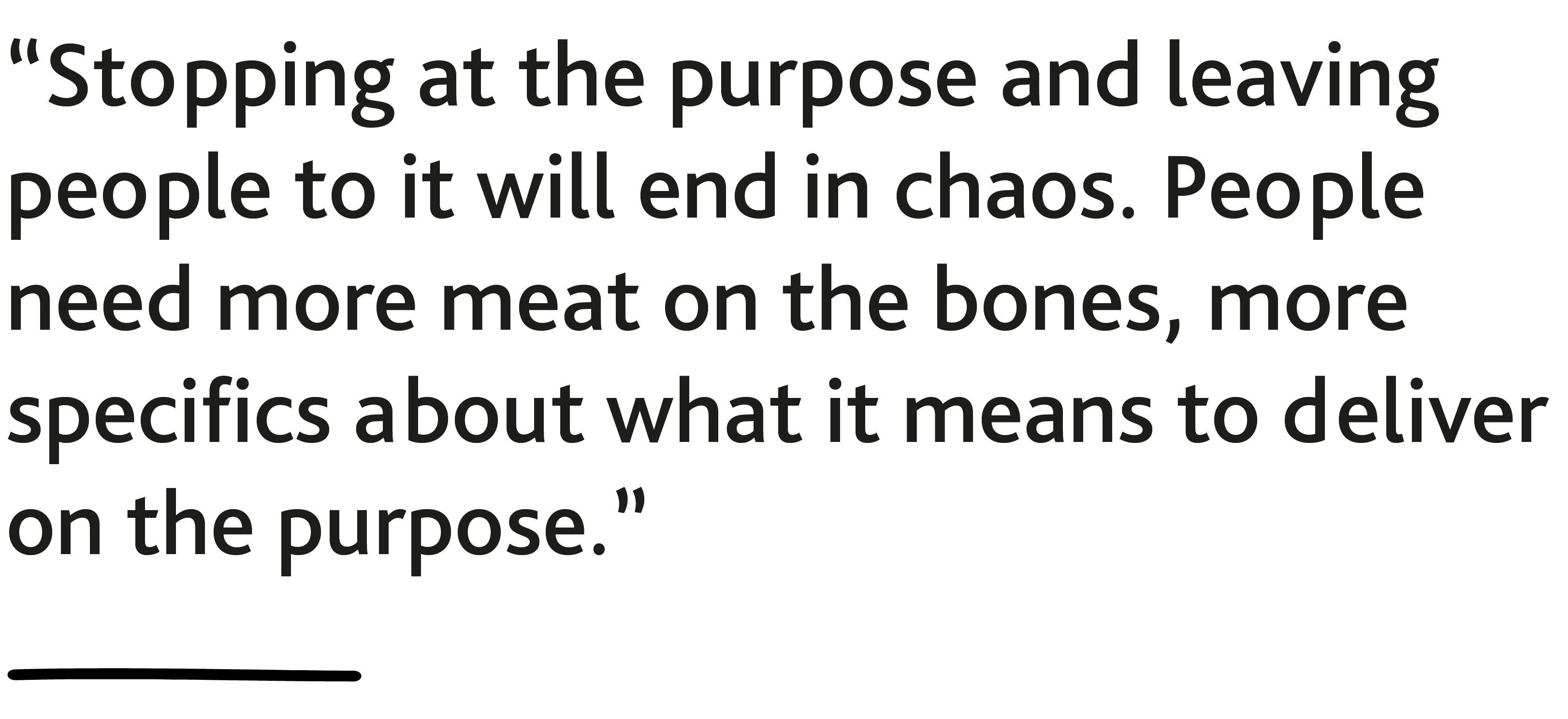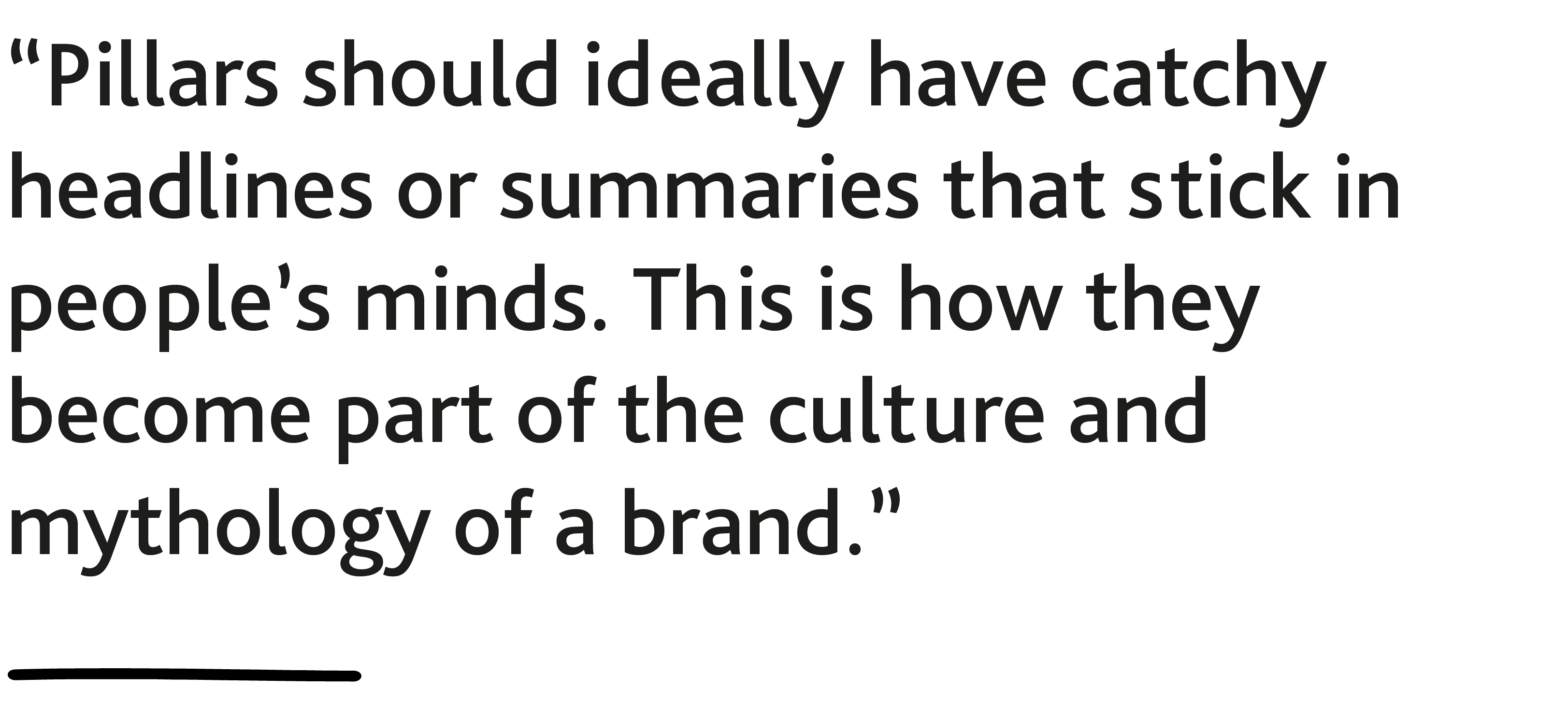Paper #7 | Pillars drive purpose through brands
There’s an ancient Japanese proverb which says: “Vision without action is a daydream; action without vision is a nightmare.” This describes the relationship between purpose and pillars. Purpose is an idea, a strategy, a direction of travel. But stopping at the purpose and leaving people to it will end in chaos. People need more meat on the bones, more specifics about what it means to deliver on the purpose. This is the role of pillars. They provide guidance on how people in the organisation should behave. And they set out the themes the brand should be focusing on in communications.
Pillars direct behaviour and communication
Since the pillars provide direction for the culture of the brand, they are a replacement for values. Pillars are better than values for two reasons. First, brands have a tendency to define values that society in general would hold to be true. Honesty and integrity for example. What’s the point in defining a value if it’s something that everyone (in the main) would be expected to live by anyway? Pillars should be more specific and action-oriented, pointing to the specific behaviours expected within the brand’s culture.

The second problem with values is that it’s easy for people to say they subscribe to them, but then behave in a diametrically opposed manner. Take Enron. The company had values which they displayed proudly in their reception area: Integrity, Communication, Respect, Excellence. Enron went bankrupt as a result of fraud, and its executives were imprisoned. When developing pillars, it is better to think in terms of behaviours rather than values. A prescribed behaviour – such as “tell the truth”, as opposed to “integrity” – is clear and unambiguous.
When developing pillars, there is a balance to be struck between their internal focus (on directing culture) and their external focus (providing themes for marketing). There is no right or wrong approach, and the only answer is to do what feels right for the brand. One factor that often (but not always) influences the balance, is whether the brand is a product- or service-based business. If a brand is sold through retail channels and there’s little direct interaction with customers, then marketing can be seen as the key driver of the organisation’s success.
The right number of pillars
There are no rules for how many are needed. We often seem to arrive at having somewhere between three and seven. Danny Meyer, the founder of renowned hospitality company Union Square Hospitality Group, has 17 pillars that support the group’s purpose, which is to “take care of people”:
- Read the guest
- Authentic hospitality
- Writing a great final chapter
- Turning up the Home Dial
- Loving problems
- Finding the yes
- Collecting the dots and connecting the dots
- Creating raves for guests
- One size fits one
- Skunking
- Making the charitable assumption
- Planting like seeds in like gardens
- Put us out of business with your generosity
- Be aware of your emotional wake
- To get a hug, you have to give a hug
- The excellence reflex
- Are you an agent or a gatekeeper?
The pillars used within the Union Square Hospitality Group are also a great example of what we call “sticky phrases”. Pillars should ideally have catchy headlines or summaries that stick in people’s minds. This is how they become part of the culture and mythology of a brand. Nearly all of the sticky phrases used by Meyer will be meaningless to most people. This is part of their value. They are only understood by people within the Union Square Hospitality Group culture. This creates a sense of belonging and communicates that “there’s a unique way of doing things around here”.

Other brands are much more rigid and structured in their approach. Disney trains the employees or cast members at its theme parks in four key behaviours that are at the heart of the guest experience:
- Safety
- Courtesy
- Show
- Efficiency
Disney attaches an order of priority to these behaviours, as they are numbered above. This helps employees determine how to behave in situations where conflicting approaches might present themselves. So if a staff member is in the middle of helping a customer, but notices that something is about to go wrong with a performance, their priority is always to be courteous to the customer they are helping before they attend to the issue with the show.
Coming next
The next in this series of Position Project Papers will be focusing on the final dimension of position: personality. If you can’t wait to start thinking about your own position, then our Position Power Tools are the ideal place to start – particularly our Calculator, which is a free self-assessment tool to measure the power of a brand’s position and assess its strengths and weaknesses. Available here.
Click below to download your Ignition Calculator
Download
Paper #6 | The second part of a position: Purpose
The most successful brands don’t just know where they compete, they define why they exist. This is vital because it gives the brand a bigger mission, a purpose that’s shared by all its people. It also allows the brand to build a deeper connection with customers beyond the functional elements of their offer. Purpose is the second part of how we define positions.

Paper #5 | The first part of a position: Space
The most successful brands take positions from the inside out. They root their position in what the brand does and a set of deeply held beliefs about why it exists. Rather than being transplanted in, the position is something that the leadership truly believes in and champions across every area of the organisation. At Squad, we have a method for defining positions in this way, which consists of three parts. First up is space, which is about defining where the brand competes.


